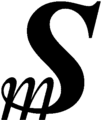Esperanto alphabet facts for kids
The Esperanto alphabet is the set of 28 (twenty-eight) letters used to write the Esperanto language. It's based on the Latin alphabet, just like the English alphabet.
Unlike English, the Esperanto alphabet doesn't use the letters q, w, x, or y. However, it has six special letters that use a diacritic (a small mark above the letter). These are: ĉ, ĝ, ĥ, ĵ, ŝ, and ŭ.
Here's a look at all the letters in the Esperanto alphabet:
| Number | 1 | 2 | 3 | 4 | 5 | 6 | 8 | 8 | 9 | 10 | 11 | 12 | 13 | 14 | 15 | 16 | 17 | 18 | 19 | 20 | 21 | 22 | 23 | 24 | 25 | 26 | 27 | 28 |
|---|---|---|---|---|---|---|---|---|---|---|---|---|---|---|---|---|---|---|---|---|---|---|---|---|---|---|---|---|
| Capital letters | A | B | C | Ĉ | D | E | F | G | Ĝ | H | Ĥ | I | J | Ĵ | K | L | M | N | O | P | R | S | Ŝ | T | U | Ŭ | V | Z |
| Small letters | a | b | c | ĉ | d | e | f | g | ĝ | h | ĥ | i | j | ĵ | k | l | m | n | o | p | r | s | ŝ | t | u | ŭ | v | z |
| IPA phoneme | = | = |
Contents
Writing Esperanto Without Special Letters
Sometimes, it's hard to type the special Esperanto letters with diacritics, especially on older computers or keyboards. Because of this, people came up with ways to write Esperanto without them.
The H-System
Ludovic Lazarus Zamenhof, who created Esperanto, suggested a method called the h-system (or h-sistemo in Esperanto). In this system, you add the letter h after the letter that would normally have a diacritic. For example:
- ĝ becomes gh
- ĥ becomes hh
- ŝ becomes sh
The only exception is ŭ, which just becomes u.
If a word looks like it has an 'h' from the h-system but doesn't, you can add a hyphen or an apostrophe to make it clear. For example, flughaveno (which means airport) could be written as flug-haveno or flug'haveno if you needed to show that 'gh' isn't a special Esperanto sound.
The X-System
Another way to write Esperanto without diacritics is the x-system (or x-sistemo). The letter x is not used in the regular Esperanto alphabet, so it's perfect to use as a replacement for diacritics.
In the x-system, you add the letter x after the letter that would normally have a diacritic. This system treats ŭ the same as the other letters. For example:
- ĝ becomes gx
- ĥ becomes hx
- ŭ becomes ux
With the x-system, words like flughaveno (airport) don't need any extra marks because there's no confusion.
How Computers Show Esperanto Letters
The special Esperanto letters are part of modern computer systems like Unicode. This means that most computers and websites can show these letters correctly. Each special letter has a unique code that helps computers display it.
Why Some People Criticize the Alphabet
Some people have different opinions about the Esperanto alphabet.
One point of criticism is about the diacritics (the special marks above letters). Some feel that using letters like ĉ, ĝ, ĥ, ĵ, and ŝ makes the language seem less natural. They point out that these specific letters are not used in many other languages around the world.
Another point of view is that the way Esperanto sounds is very similar to the Polish way of speaking from Białystok. This is interesting because Białystok was the hometown of L. L. Zamenhof, the creator of Esperanto.
Also, some people believe that using the Latin alphabet (the one English uses) isn't completely "neutral" for a language meant for everyone. However, it's important to remember that many languages across different continents use the Latin alphabet. For example, German in Europe, Swahili in Africa, Vietnamese in Asia, Tahitian in Oceania, Cree in North America, and Apalaí in South America all use the Latin alphabet.
Images for kids
-
Ĉu vi parolas la rusan? (Do you speak Russian?) written in the Cyrillic alphabet.
-
An Esperanto pangram (a sentence using every letter of the alphabet) in the Juliamo alphabet. It says: Laŭ Ludoviko Zamenhof bongustas freŝa ĉeĥa manĝaĵo kun spicoj.
See also
 In Spanish: Ortografía del esperanto para niños
In Spanish: Ortografía del esperanto para niños



